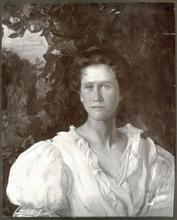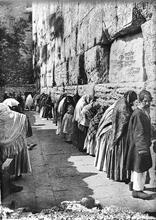Judith Montefiore
Born in 1784 to a prominent, religious observant Ashkenazi family, Judith Cohen married Moses Montefiore, a Sephardi Jew of Italian origin, in 1812. Moses was one of the most prominent Jews of the nineteenth century, and Judith became known as the “First Lady of Anglo Jewry.” She was a full partner in all her husband’s communal affairs and public activities and was a very active philanthropist, extremely involved as a patron of a host of charities and social work endeavors. Judith Montefiore also traveled extensively with her husband to save and protect endangered Jews around the world, keeping extensive diaries of her travels. She is also thought to be the author of the first Jewish cookbook in English.
Many people fail to distinguish the achievements of Lady Judith Montefiore from those of her husband Sir Moses Montefiore (1784–1885), who was one of the most important Jews of the nineteenth century. Nonetheless, the life of this “First Lady of Anglo Jewry” is of significance both to Anglo-Jewish history and to the history of Jewish women. While embodying all the Victorian virtues of high moral purpose, sense of duty, charity, and public–mindedness, she was a fierce loyalist to her faith and her people, devoted to Jewish causes and the welfare of Jews the world over.
Early Life and Family
Montefiore was born on February 20, 1784 to a prominent, religiously observant Jews of European origin and their descendants, including most of North and South American Jewry.Ashkenazi family. Her father, Levi A. Barent Cohen (1740–1808), a wealthy Dutch businessman, had settled in London in the 1770s. She was given a strong education in languages, for which she had a great flair, including French, German, Italian, and Hebrew (later she learned Arabic, too), as well as an intensive background in literature, music, and art.
In 1812 Judith Cohen married Moses Montefiore, a Descendants of the Jews who lived in Spain and Portugal before the explusion of 1492; primarily Jews of N. Africa, Italy, the Middle East and the Balkans.Sephardi Jew of Italian origin, after her sister Hannah (1783–1850) married Nathan Mayer Rothschild, the head of the Rothschild family in England. Her Chinese silk wedding gown was later, in 1833, donated to the synagogue when they lived in Ramsgate; it was then recycled into a Torah mantle (me’il) and a cover for the reader’s desk, as was customary in many Sephardi and Italian families. The couple’s connection with the Rothschild family was strengthened when Moses Montefiore’s brother married a sister of Nathan Mayer.
Philanthropy and Travel
After considerable success on the London Stock Exchange and other business ventures, Moses Montefiore was able to retire and devote himself to Jewish communal affairs. Judith became a full partner in all his communal affairs and public activities. She was a very active philanthropist, extremely involved as a patron of a host of charities and social work endeavors. She was a patron of the Jewish Ladies’ Loan and Visiting Society, an officer of the Jews’ Orphan Asylum, and worked towards the education of young girls at the Jews’ Hospital.
Judith traveled extensively with her husband to save and protect endangered Jews around the world. She accompanied him to Damascus after the Blood Libel in 1840 and to Russia in 1846 to protest the expulsion of Jews from border areas of Russian Poland. She joined him on five of his seven trips to the Holy Land. Their first trip was really a pilgrimage; later trips were intended to help the Jewish community in Palestine, and the couple played a major role in the development of the country and its agricultural settlements, in the growth of Jerusalem, and in fostering Jewish independence and productivity in Palestine.
Both Judith and her husband kept extensive diaries. Of hers, only her honeymoon diaries and two travel journals are extant. The honeymoon diaries cover the first six months of her marriage in 1812 and then about two and a half weeks in 1825. Her affection and feelings for her husband are very apparent. All her writings have a serious piety and moral tone, as well as a very positive attitude to her religion. Two days after her wedding, she wrote that she did “not know any circumstances more pleasing to me than to perceive that her dear Monte is religiously inclined” (“Lady Montefiore’s Honeymoon, 10).
Judith Montefiore kept a diary of their first visit to Palestine, which took place between February 20, 1827, and May 1828. The diary was printed for private circulation in 1836. While her diaries are similar to those of other nineteenth-century travelers to the Holy Land, her knowledge of and sensitivity to the currents and flows of Jewish history give her writings a special quality. On visiting Rachel’s Tomb, she related that her feelings of gratitude were increased by knowing that only six European women had visited Palestine during the course of the century and that she “was deeply impressed with a feeling of awe and respect, standing as I did, in the sepulcher of a mother in Israel.” In fact, she was behind her husband’s plans to restore Rachel’s Tomb, and after she died, he actually modeled the design of her tomb on Rachel’s Tomb in Palestine. In her diary of their second visit to Palestine in 1838, she writes of her joy at attending the opening of a new synagogue in Safed built a year after the major earthquake that had killed more than 2000 Jews. She describes riding on horseback around the walls of Jerusalem and visiting six different synagogues, both Ashkenazi and Sephardi, in rapid succession. In one of them she was given the honor “of lighting four lamps in front of the altar and putting bells on the ‘Sefer”’ (Torah Scroll). She writes of women coming to her specifically for financial help, asking her “to become patroness of the charity and to allow my name to be placed at the head of the institution.” Clearly, the women in places she visited were greatly inspired by her personality and activities.
First Jewish Cookbook in English
Apart from her diaries, there are no other extant publications under Judith Montefiore’s name. However, scholars consider that she was the author of the first Jewish cookbook in English: The Jewish Manual: or Practical Information in Jewish & Modern Cookery; with a Collection of Valuable Recipes and Hints Relating to the Toilette, edited by a Lady, which was published in 1846, fifteen years before Mrs. Beeton’s classic work The Book of Household Management and 25 years before Esther Levy produced the first American-Jewish cookbook in 1871, designed to help new immigrants adapt to American life. In his excellent introduction to the facsimile edition of the cookbook, Chaim Raphael clearly identifies Judith Montefiore as the anonymous “lady.” His attribution is based in part on the fact that the gooseberry-based desert included in the cookbook is called a “Juditha.” More significantly, Raphael writes that, in reporting the details of the memorial to be set up in Judith Montefiore’s name to provide dowries for young Jewish girls, The Jewish Chronicle of October 10,1862, cited Chief Rabbi Nathan Adler, who, in his Yom Kippur sermon, had said that the choice of memorial was most fitting because Lady Montefiore had “attached great importance to the due qualifications of females for the discharge of domestic duties in which she herself excelled, and wrote a book for Jewish cookery, or at least assisted in its composition.”, Montefiore’s cookbook clearly reflected her social position and was directed at ladies who maintained households with servants. She adapted recipes to conform to Jewish dietary laws, replacing ingredients such as lard, so widely used in English kitchens, and eliminating shellfish and forbidden meats. Her section on the toilette is “Victorian” in tone. She recommended simplicity in dress, considered delicate hands a mark of elegance and refinement, and carefully assessed the effect of diet on the complexion. The key to her admonitions was that “the face and body are indexes of the mind.”
Partnership with Her Husband
Judith Montefiore’s husband always acknowledged her contribution to his public work. Prayers and poems written in honor of her husband always included her, and books printed all over the Jewish world were dedicated to her or to her memory, such as the popular book of devotions compiled in German by the poet Meir Letteris (1800?–1871) and later translated into other languages. When Judith died in 1862 on Rosh Hashanah (September 24), Moses Montefiore established in her memory the Judith Lady Montefiore College, a rabbinical training college at Ramsgate, where they had lived. Until his death in 1885 he continued to credit her for the successes and achievements of his career. The fact that the Montefiores were childless has been attributed to Judith’s infertility. The situation certainly caused them great sadness and was a void in their lives (it has been speculated that Judith’s decision to donate her wedding gown in 1833 to be recycled into Torah vestments marked the end of her hopes for motherhood, and perhaps her donation to the synagogue allowed her to come to terms with her loss), but it also perhaps freed her to travel constantly with her husband and take advantage of her language skills. Her travelling was unusual and often dangerous and she can be considered an important Jewish travel writer, at a time when female travel writers were rare, as well as an important Jewish activist on the international scene, especially involved in all her husband’s efforts to revitalize Jewish life in the Holy Land.
Works by Judith Montefiore
Montefiore, Judith. Private Journal of a Visit to Egypt and Palestine (written in 1827–1828 and printed for private circulation in 1836). The second section relating to Egypt and Palestine (pp. 128–234) has been reproduced by Yad Yitzhak Ben Zvi, Jerusalem: 1975.
Notes from a Journal of a visit to Palestine by way of Italy and the Mediterranean. London: J. Rickerby, 1844. Second edition London: Wertheimer, Lea,1885. Translated into Hebrew under the title Yehudit (London, undated; probably 1879–1880).
The Jewish Manual: or, Practical Information in Jewish and Modern Cookery, with a Collection of Valuable Recipes and Hints Relating to the Toilette, edited by a Lady. London: T. & W. Boone, 1846. Reprint with an introduction by Chaim Raphael, Cold Spring, New York: 1983.
Breger, Jennifer. “Three Women of the Book: Judith Montefiore, Rachel Morpurgo and Flora Sassoon.” In AB Bookman’s Weekly 101 (March 30, 1998): 853–864.
Green, Abigail. “Spirituality, Tradition and Gender: Judith Montefiore, the Very Model of a Modern Jewish Woman.” History of European Ideas Vol. 40, No. 6 (2014): 747-760.
Lipman, Sonia. “Judith Montefiore, First Lady of Anglo Jewry.” The Jewish Historical Society of England, Transactions 21 (1968): 287–303.
Loewe, Louis. Diaries of Sir Moses and Lady Montefiore. London: Griffith, Farran, Okeden & Welsh, 1890. Facsimile edition London: 1983.
Page, Judith W. “Jerusalem and Jewish Memory: Judith Montefiore’s Private Journal.” Victorian Literature and Culture, Vol. 27, No.1, (1999): 125-143.
Wolf, Lucien. “Lady Montefiore’s Honeymoon: An Unpublished Diary.” London: 1902. Reprinted in Essays in Jewish History, edited by Cecil Roth, 231–258. London: 1934.





